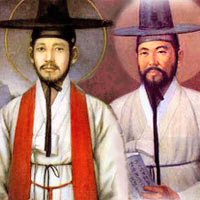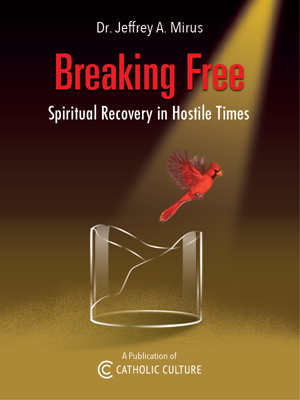Ordinary Time: September 20th
Memorial of Sts. Andrew Kim Tae-gon, Priest, & Paul Chong Ha-sang, and Companions, Martyrs; Ember Friday
Other Commemorations: St. Eustace, Martyr (RM) ; Other Titles: Eustachius
» Enjoy our Liturgical Seasons series of e-books!
Today is the Memorial of Saints Andrew Kim Tae-gŏn, Priest, and Paul Chŏng Ha-sang, and Companions, Martyrs. During the 17th century the Christian faith was brought to Korea through the zeal of lay persons. From the very beginning these Christians suffered terrible persecutions and many suffered martyrdom during the 19th century. Today's feast honors a group of 103 martyrs. Most were murdered during waves of persecutions in 1839, 1846 and 1867. Notable of these were Andrew Kim Taegon, the first Korean priest, and the lay apostle, Paul Chong Hasang. Also among the Korean martyrs were three bishops and seven priests, but for the most part they were heroic laity, men and women, married and single of all ages. They were canonized by Pope Saint John Paul II on May 6, 1984.
The Roman Martyrology also commemorates St. Eustace and his companions (d. 188). He was a martyr whose cult was introduced at Rome in the early Middle Ages and one of the Fourteen Holy Helpers.
Today is Ember Friday of the Autumn or September Embertide. The September Ember Days fall after the third Sunday of September near the Feast of the Exaltation of the Holy Cross (September 14), and are days of thanksgiving for the completed harvest of fruits and grapes, being historically commemorated as a "wine-press feast." But these Ember Days are also days of penance and atonement since the traditional liturgy connected them with the Jewish celebration of the New Year and Day of Atonement, Yom Kippur. The Stational churches were part of the Ember Days, with Ember Fridays always being the Station with the Twelve Holy Apostles (Santi Dodici Apostoli, also Santi Apostoli).
See September or Fall Ember Days and Contemporary Observation of Ember Days.
St. Andrew Kim Taegon and St. Paul Chong Hasang and their companions
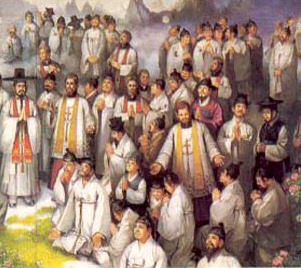 This first native Korean priest was the son of Korean converts. His father, Ignatius Kim, was martyred during the persecution of 1839 and was beatified in 1925. After baptism at the age of fifteen, Andrew traveled thirteen hundred miles to the seminary in Macao, China. After six years he managed to return to his country through Manchuria. That same year he crossed the Yellow Sea to Shanghai and was ordained a priest. Back home again, he was assigned to arrange for more missionaries to enter by a water route that would elude the border patrol. He was arrested, tortured and finally beheaded at the Han River near Seoul, the capital. Paul Chong Hasang was a lay apostle and a married man, aged forty-five. Christianity came to Korea during the Japanese invasion in 1592 when some Koreans were baptized, probably by Christian Japanese soldiers. Evangelization was difficult because Korea refused all contact with the outside world except for an annual journey to Beijing to pay taxes. On one of these occasions, around 1777, Christian literature obtained from Jesuits in China led educated Korean Christians to study. A home church began. When a Chinese priest managed to enter secretly a dozen years later, he found four thousand Catholics, none of whom had ever seen a priest. Seven years later there were ten thousand Catholics. Religious freedom came in 1883.
This first native Korean priest was the son of Korean converts. His father, Ignatius Kim, was martyred during the persecution of 1839 and was beatified in 1925. After baptism at the age of fifteen, Andrew traveled thirteen hundred miles to the seminary in Macao, China. After six years he managed to return to his country through Manchuria. That same year he crossed the Yellow Sea to Shanghai and was ordained a priest. Back home again, he was assigned to arrange for more missionaries to enter by a water route that would elude the border patrol. He was arrested, tortured and finally beheaded at the Han River near Seoul, the capital. Paul Chong Hasang was a lay apostle and a married man, aged forty-five. Christianity came to Korea during the Japanese invasion in 1592 when some Koreans were baptized, probably by Christian Japanese soldiers. Evangelization was difficult because Korea refused all contact with the outside world except for an annual journey to Beijing to pay taxes. On one of these occasions, around 1777, Christian literature obtained from Jesuits in China led educated Korean Christians to study. A home church began. When a Chinese priest managed to enter secretly a dozen years later, he found four thousand Catholics, none of whom had ever seen a priest. Seven years later there were ten thousand Catholics. Religious freedom came in 1883.
When Pope John Paul II visited Korea in 1984, he canonized Andrew, Paul, ninety-eight Koreans and three French missionaries who had been martyred between 1839 and 1867. Among them were bishops and priests, but for the most part they were laypersons: forty-seven women, forty-five men.
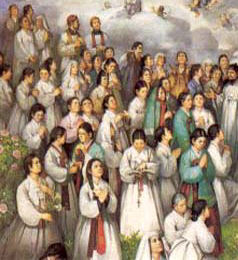 Among the martyrs in 1839 was Columba Kim, an unmarried woman of twenty-six. She was put in prison, pierced with hot awls and seared with burning coals. She and her sister Agnes were disrobed and kept for two days in a cell with condemned criminals, but were not molested. After Columba complained about the indignity, no more women were subjected to it. The two were beheaded. A boy of thirteen, Peter Ryou, had his flesh so badly torn that he could pull off pieces and throw them at the judges. He was killed by strangulation. Protase Chong, a forty-one-year-old noble, apostatized under torture and was freed. Later he came back, confessed his faith and was tortured to death.
Among the martyrs in 1839 was Columba Kim, an unmarried woman of twenty-six. She was put in prison, pierced with hot awls and seared with burning coals. She and her sister Agnes were disrobed and kept for two days in a cell with condemned criminals, but were not molested. After Columba complained about the indignity, no more women were subjected to it. The two were beheaded. A boy of thirteen, Peter Ryou, had his flesh so badly torn that he could pull off pieces and throw them at the judges. He was killed by strangulation. Protase Chong, a forty-one-year-old noble, apostatized under torture and was freed. Later he came back, confessed his faith and was tortured to death.
Today there are approximately four million Catholics in Korea.
—Excerpted from the Saint of the Day, Leonard Foley, O.F.M.
Patronage: Korean clergy.
Symbols and Representation: Palm frond (for martyrdom); martyr's crown.
Highlights and Things to Do:
- Study the emphasis of the role of the laity in the Church especially in this century, and decide on things you can do as a layperson to help your parish community.
- Read Pope John Paul II's homily at the canonization of the 103 Korean Martyrs, read about some of the other Korean martyrs.
- Read more about St. Andrew Kim and the Korean Martyrs:
- Find out where St. Andrew Kim's relics are enshrined.
- See Catholic Cuisine for some feast food ideas.
St. Eustace and His Companions
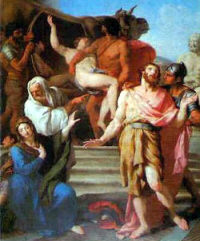 The charming legend of Saint Eustace tells how a Roman general named Placidus was once out hunting. He pursued a noble stag, which suddenly turned and approached him. Between the stag's antlers Placidus saw a crucifix. A voice was calling him by name.
The charming legend of Saint Eustace tells how a Roman general named Placidus was once out hunting. He pursued a noble stag, which suddenly turned and approached him. Between the stag's antlers Placidus saw a crucifix. A voice was calling him by name.
The hunter himself had been caught. The vision converted Placidus. He changed his name to Eustace, and gave away much of his money.
The saint still felt able to serve the Roman emperor. Taking up his command again, he led the legions to great victories. By this time his family had become Christian too, and all four of them — Eustace, his wife Theopista, and his sons Agapetus and Theopestus — refused to make sacrifices to pagan gods in the celebrations following his own victories.
All four were accordingly put to death in a bizarre fashion. They were taken to the colosseum in Rome, encased in a bronze bull, and roasted to death.
Although these events are supposed to have taken place around the year 118, no account of Saint Eustace and his family has been found prior to the seventh century. Yet he became one of the most popular saints in the middle ages, celebrated in prose and poetry as well as in art and popular devotion. Eustace is one of the Fourteen Holy Helpers, and he is venerated as the patron of hunters.
—Excerpted from the A Calendar of Saints by James Bentley
The "Fourteen Auxiliary Saints" or "Fourteen Holy Helpers" are a group of saints invoked because they have been efficacious in assisting in trials and sufferings. Each saint has a separate day for commemoration, and the group was collectively venerated on August 8, until the 1969 reform of the Roman calendar, when the feast was removed from the universal calendar. See Fourteen Holy Helpers and August 8 for more details.
Patronage: against fire; against torture; difficult situations; fire prevention; firefighters; hunters, hunting, huntsmen; torture victims; family troubles; trappers; in Italy; Acquaviva delle Fonti, diocese of Altamura–Gravina–Acquaviva delle Fonti, Cacciatori, Poli, Tocco da Casauria; Madrid, Spain.
Symbols and Representation: bull; oven; crucifix; stag; oven; white stag on a rock, with a crucifix between antlers; boar spear; hunter's horn; lion; Roman armor; bear, wolf or dog; wicker basket; brazen bull with a fire under it.
Highlights and Things To Do:
- Read more about St. Eustace:
- See the beautiful stained glass windows of Chartres Cathedral depicting the life of St. Eustace.
- St. Eustace's story is similar to St. Hubert, also a patron of hunters. Depending on the cultural or geographical region would determine devotion to which hunter saint. See Fourteen Holy Helpers and November 3 for more details on St. Hubert.
- See Catholic Cuisine for hunter food ideas.
Meditation: Ember Friday in September, “Do penance”
This excerpt from Benedict Baur is based on the 1962 Missal. The current Missal does not include special propers and readings for Ember Days.
At the church of the Twelve Apostles we were absolved of our sins on Holy Thursday and received again into the community of the Church and reconciled with God. Today we assemble again at this stational church to do penance for the sins and infidelities of the last three months and to obtain pardon. We come with Magdalen, the sinner and penitent, to hear from Christ Himself the words: “Thy faith hath made thee safe; go in peace” (Gospel). “Let the heart of them rejoice that seek the Lord; seek ye the Lord and be strengthened” (Introit).
“Return, O Israel, to the Lord thy God; for thou hast fallen down by thy iniquity. Take with you words and return to the Lord and say to Him: “Take away all iniquity and receive the good, and we will render the calves of our lips…Neither will we say anymore: The works of our hands are our gods” (Epistle). Thus we are called to do penance with a contrite and humble heart and to confess to the Lord. Magdalen is an example for us. She comes to the Lord and throws herself at His feet. She washes His feet with tears, kisses them, and anoints them with the ointment she has brought with her. She comes with a heart full of shame, full of contrition, full of courage, in self-accusation and humility. She is determined to amend her life. The Lord responds to this contrition and love which He Himself through His mercy planted in the heart of the sinful woman. “Many sins are forgiven her, because she hath loved much; but to whom less is forgiven, he liveth less. And He said to her: Thy sins are forgiven thee” (Gospel). We, too, are sinners. We, too, are penitent. We come to Him in the Holy Sacrifice, when He appears in our midst. We confess to Him that we have sinned and have offended God. We accuse ourselves in the presence of His representative. We hear the consoling words: “I absolve thee of thy sins. Go in peace.” We obtain pardon in proportion to our contrition and love. “To whom less is forgiven, he liveth less.” But on the other hand, less is forgiven to Him who loves less.
“I will heal their breaches, I will love them freely; for My wrath is turned away from them. I will be as the dew; Israel shall spring as the lily, and his root shall shoot forth as that of Libanus. His branches shall spread, and his glory shall be as the olive tree, and his smell as that of Libanus…. They shall live upon wheat [the Eucharist], and they shall blossom as a vine” (Epistle). With great tenderness and charity the Lord accepts the contrite, penitent soul, as is clear from His reception of the sinner Magdalen. Simon the Pharisee is a witness against the sinner who entered and threw herself at the feet of Jesus. He says to himself, “This man, if He were a prophet, would know surely who and what manner of woman this is that toucheth Him, that she is a sinner” (Gospel). But the Lord has come in search of sinners that He may save them. He has no word of blame for Magdalen. He does not wait until He is begged before she is allowed to appear before Him. He draws her with the power of His love and grace, and He forgives her entire debt. She renounces the false gods she has served till now, and follows the Lord. She is the first of the holy women to see the risen Savior. She received special graces and becomes a great saint, whom we may all admire and imitate.
The self-righteous Pharisee, who has invited the Lord for dinner and the sinful, penitent, contrite Magdalen present a striking contrast. The Pharisee is a type of the Jewish people, while Magdalen represented those converted from the Gentiles. In the mind of the liturgy, we are the contrite Magdalen, for the first step to grace and holiness is penitence.
We give expression to our repentance when we fast on Ember days. We sanctify our fast through the celebration of the Eucharistic sacrifice. At this sacrifice we unite our fasting and penance to the suffering and death of the Lord, and we beseech God that He may be pleased with the sacrifice of our fast and make us worthy of His grace, which we expect from the Mass. This grace will lead us to the promises of eternal life (Secret).
Christians in our day seem to have lost their sense of the necessity of penance and reparation. It is therefore even more necessary to accompany the liturgy today into the house of Simon the Pharisee and learn from the example of Mary Magdalen, how to do penance for our sins. From this holy penitent we can learn to trust in the mercy of the Lord, and thus to be purified so that we may share His blessedness.
Prayer: Grant, O almighty God, we beseech Thee, that by our devout keeping of the holy observances year by year, we may in body and in soul give pleasure to Thee. Through Christ our Lord. Amen.
—from The Light of the World, Volume Three by Benedict Baur, O.S.B.
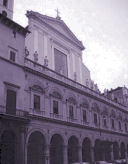
Ember Friday of the Autumn or September Embertide
Station with Santi Dodici Apostoli (also Santi Apostoli, the Twelve Holy Apostles):
Traditionally, this is the place where the Romans choose their candidates for priesthood (Rite of Election). It was erected by Julius I (337-352) over the barracks of ancient Rome's firemen and entrusted since 1463 to the Conventual Franciscans. Originally dedicated to the Apostles St. James and St. Philip, it was rededicated to all the Apostles in the 16th century.
The Church leads us today to the "the twelve apostles," on whom the Lord conferred His power to forgive and retain sins. Bearers they are of those precious keys that open the merciful heart of God as well as the contrite heart of man, uniting the latter to the former by means of the cleansing and sanctifying blood of Jesus Christ. This Ember Friday is an appropriate occasion for giving our weekly "Friday-abstinence" a new spirit. So often we observe the day thoughtlessly—perhaps even reluctantly....Give your soul a new direction by a fruitful "ember confession." The sacrament of penance is the sacrament of liberty which frees us from the disgracing chains of our sins. True humility and sorrow are oil from the Holy Spirit which make the "keys of forgiveness" turn with heavenly smoothness. "Remove from me reproach and contempt, because I have sought out Thy commandments, O Lord; for They testimonies are my meditation."
For more on Santi Dodici Apostoli, see:
For further information on the Station Churches, see The Stational Church.




